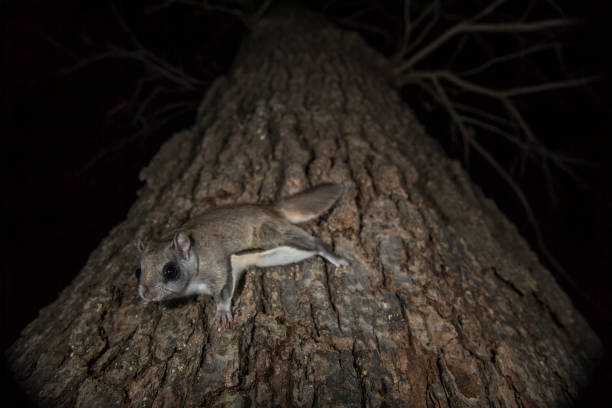Table of Contents
Scientific Classification
| Kingdom | Animalia |
| Phylum | Chordata |
| Class | Mammalia |
| Order | Rodentia |
| Family | Sciuridae |
| Genus | Pteromyini (tribe) / varies by species |
| Species | Multiple species |
| Scientific Name | aries (e.g., Glaucomys volans – Southern Flying Squirrel) |
Description
Flying squirrels are truly some of the most delightful creatures in nature. While they don’t actually fly, they glide effortlessly from tree to tree. With their big, expressive eyes and soft fur, they seem almost magical as they navigate the woods. These nocturnal rodents have a unique membrane called the patagium, which stretches from their wrists to their ankles. This special flap of skin allows them to glide distances of up to 300 feet!
There are over 50 species of flying squirrels scattered across the globe, and they fall into two main categories: New World and Old World species. In North America, the Southern Flying Squirrel (Glaucomys volans) and the Northern Flying Squirrel (Glaucomys sabrinus) are the most recognized. These little mammals typically weigh between 2 to 5 ounces and measure around 8 to 12 inches long, including their tails.
Despite their delicate appearance, they zip around the treetops with impressive speed and agility. Their large eyes are perfect for nighttime vision, giving them a wonderfully curious expression.

Distribution
Flying squirrels can be spotted across various continents, with their specific habitats differing from one species to another. In North America, for instance, the Southern Flying Squirrel makes its home in the eastern United States and parts of Mexico. Meanwhile, the Northern Flying Squirrel prefers the chillier climates of Canada, Alaska, and the northern U.S.
Over in the Old World, flying squirrels are primarily found in Asia and parts of Europe, and they tend to be on the larger side. A notable example is the Siberian Flying Squirrel (Pteromys volans), which you can find in places like Finland, Russia, and several Asian countries.
Despite their widespread presence, these creatures often go unnoticed because of their shy and nocturnal nature. However, they play a crucial role in the ecosystems they inhabit.
Habitat
Flying squirrels are the acrobats of the treetops. They thrive in mature deciduous and mixed forests, where the trees provide perfect spots for gliding, nesting, and foraging. With their tall branches interconnecting, these trees allow them to navigate the canopy without ever touching the ground, keeping them safe from any lurking predators.
When it comes to nesting, they often choose old woodpecker holes, hollow trees, or even abandoned bird nests. In colder regions, some species lean towards coniferous forests, which offer excellent insulation against the chill.
Unfortunately, these charming squirrels are feeling the pinch of deforestation. As old trees vanish, they lose not only their nesting sites but also their flight paths. That’s why protecting mature forests is crucial for their survival.
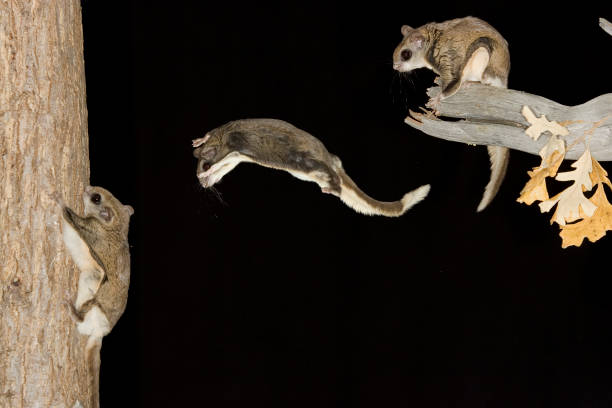
Diet
Flying squirrels are omnivores with a diverse and opportunistic diet. Their menu varies seasonally and includes:
- Nuts (especially acorns)
- Seeds
- Fruits and berries
- Fungi and lichens
- Insects
- Bird eggs and small nestlings (occasionally)
- Tree sap and bark
In winter, they may rely more on bark and stored food. Their varied diet helps maintain a balanced forest ecosystem.
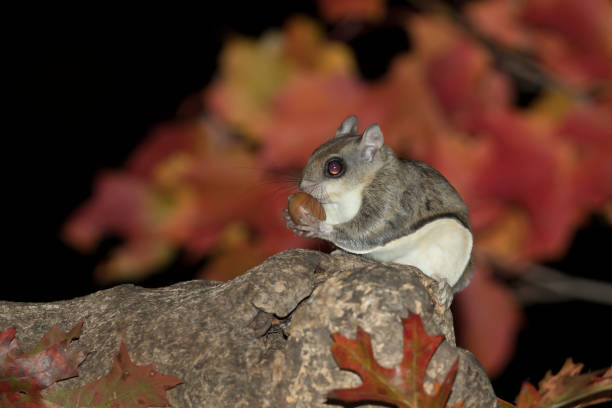
Behavior
Flying squirrels are mostly active at night, coming out of their nests just after the sun goes down. With their excellent night vision, they move around quietly, patrolling their territory with ease. These little critters are quite social, especially during the winter months when many of them cozy up together in a den to keep warm.
They communicate using a variety of high-pitched chirps and ultrasonic sounds, most of which are too faint for us humans to hear. These vocalizations serve different purposes, like attracting mates, warning each other of danger, or just keeping in touch with their buddies.
Their ability to glide isn’t just a neat trick; it’s a vital part of their survival. By gliding from tree to tree, they can steer clear of ground predators and conserve energy that they would otherwise spend climbing.
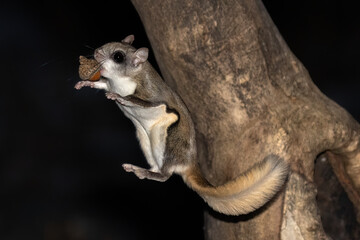
Lifespan
Flying squirrels typically have a lifespan of about 5 to 6 years in the wild. However, if they manage to avoid predators and other environmental threats, some can live up to 10 years. In captivity, where they have a steady food supply and no predators to worry about, they can live even longer—often reaching around 12 years.
Juvenile flying squirrels face the highest risk of mortality, especially during their first few glides, when falls are more common.
Reproduction and Lifecycle
Flying squirrels typically breed once or twice a year, depending on the climate and food availability. After mating, the female either builds a new nest or repairs an existing one, and about 40 days later, she gives birth.
A usual litter consists of 2 to 6 little ones. When they’re born, the pups are hairless, blind, and entirely reliant on their mother.
The young squirrels stick close to their mom for a few weeks before they start to explore on their own. They usually reach maturity around 9 to 12 months of age.
Predators
Flying squirrels may be skilled in the air, but they have to watch out for a variety of natural predators, such as:
– Barred Owls
– Hawks
– Snakes
– Raccoons
– Domestic Cats
– Martens
Their best strategy for survival? Avoidance! They rely on the cover of darkness and their stealthy nature to stay hidden. Thanks to their patagium, they can swiftly change direction while gliding, which often leaves predators baffled and unable to catch them.
Nest
Flying squirrels are quite the architects! They build cozy nests that are not only warm and dry but also cleverly hidden away. You might find them lining tree cavities or crafting leafy dreys using twigs, moss, and feathers. During the chilly winter months, they often share these nests with other squirrels, which is a pretty unique behavior compared to many other squirrel species.
In suburban areas, these little critters tend to make themselves at home in attics, sheds, or even wall spaces. This can sometimes lead to a bit of a clash between humans and wildlife.
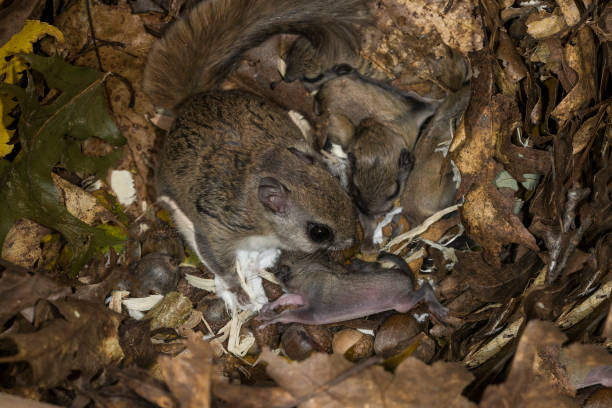
Adaptations
The flying squirrel is truly a wonder of evolution, perfectly adapted for life high up in the trees. Here are some of its key features:
Patagium: This unique gliding membrane stretches between its limbs, functioning like a parachute.
Cartilage Spur: A special piece of cartilage extends from the wrist, supporting the patagium.
Flattened Tail: This tail acts as both a stabilizer and a rudder while flying.
Large Eyes: These enhance its ability to see in low light.
Sharp Claws: Perfect for climbing and gripping onto tree bark.
Flexible Ankles: They allow the hind feet to rotate backward, making it easier to descend vertical surfaces.
All these adaptations enable flying squirrels to thrive in their arboreal environment, helping them forage for food, dodge predators, and explore their surroundings while conserving energy.
Mating Season
Flying squirrels typically mate in late winter, from January to March. However, if the conditions are right, they might also breed in mid-summer, between June and August. In the southern regions, these little critters can have two litters each year, while those in colder areas usually only reproduce once annually.
During mating season, males often engage in battles to win over females. Once mating occurs, the female takes on the responsibility of raising the young all on her own.
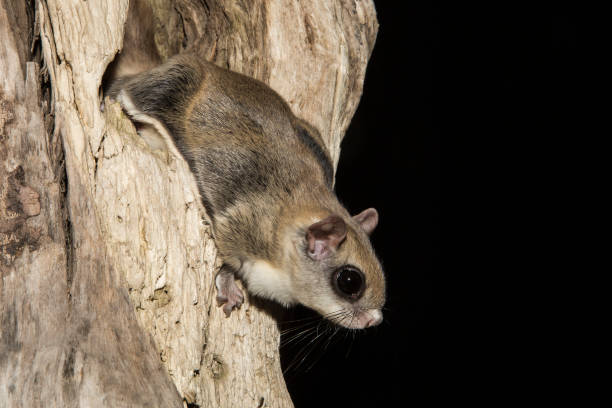
Breeding
Breeding is crucial for flying squirrels. They require safe nests and an abundance of food. The female is quite selective about where she nests, which significantly boosts the chances of her young surviving. After giving birth, she dedicates most of her time to nursing and grooming her little ones until they’re ready to take their first glides.
If the circumstances are favorable, she might breed again within the same year, but only if her health permits it. The level of parental care is substantial, and females can be incredibly protective of their offspring.
Interesting Facts
- They Don’t Actually Fly: Even with their name, flying squirrels don’t fly like bats or birds. Instead, they glide using their patagium.
- Record Gliders: Some species can glide over 300 feet (91 meters) in a single leap.
- Ultrasonic Calls: Some species communicate using ultrasonic sounds. They especially use these sounds for navigation in the dark.
- Communal Living: In winter, they often live together. This behavior is rare in most squirrel species.
- They Glow: North American flying squirrels glow pink under UV light. Scientists are still studying this phenomenon.
- Quiet Navigators: They move quietly, helping them stay hidden in dense forests.
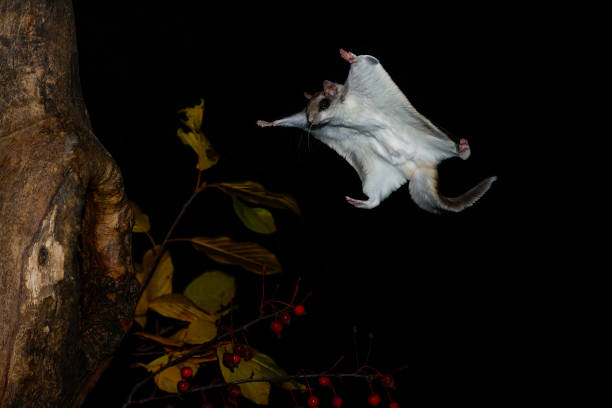
Conservation Status
When it comes to flying squirrels, most species are considered to be of Least Concern by the IUCN. This is largely because they have a wide distribution and their populations are generally stable. However, some local groups, particularly in Asia and parts of Europe, are facing challenges. These challenges stem from habitat loss, deforestation, and the impacts of climate change.
Take the Carolina Northern Flying Squirrel (Glaucomys sabrinus coloratus), for instance. This particular species is classified as Endangered in the U.S. due to its limited range in the Appalachian Mountains.
Conservation initiatives are focused on safeguarding old-growth forests, which are crucial for these creatures. Efforts include restricting logging in essential habitats and raising public awareness about these fascinating and elusive mammals.
Flying squirrels are truly some of the most intriguing and ecologically important inhabitants of the forest. Despite their secretive nature, they play a vital role in maintaining the balance of their ecosystems. By protecting their habitats, we not only help them thrive but also ensure the intricate web of forest life remains intact.
